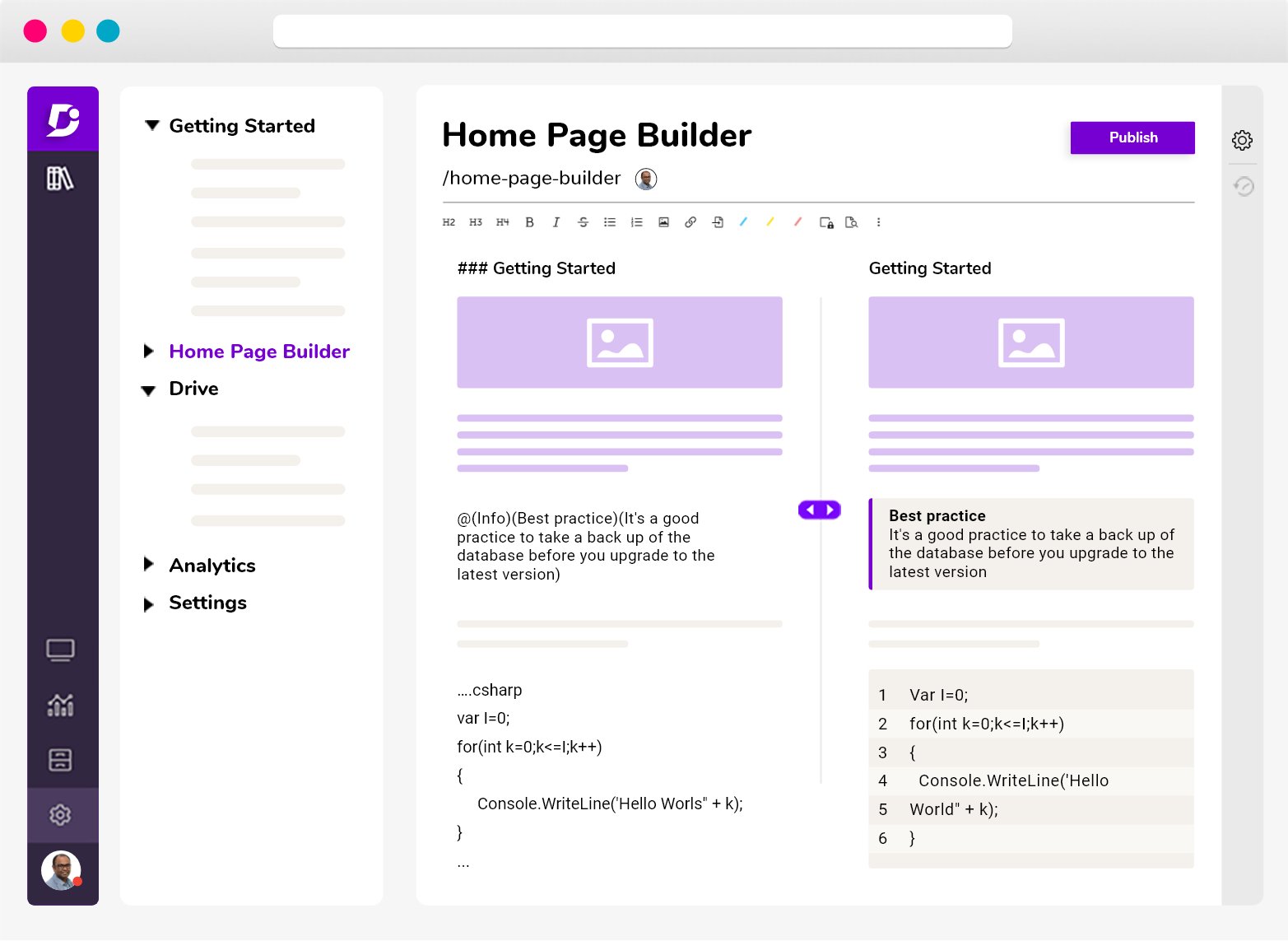In today’s knowledge-driven economy, organizations are increasingly recognizing the need of efficiently managing their intellectual assets. Research conducted by the APQC (American Productivity & Quality Center) found that companies with robust knowledge management frameworks experienced a 33% reduction in the time required to develop new products and services.
But have you ever wondered how organizations harness the power of knowledge to propel their growth and stay ahead of the curve? That’s where knowledge management frameworks come into play. They serve as the guiding principles and strategies that enable businesses to effectively create, organize, and share their wealth of knowledge.
This guide explores knowledge management frameworks, including their components, benefits, and how to create your own.
What is a knowledge management framework?
A framework is a structure or blueprint that provides guidance and support for achieving a specific goal or objective.
It helps organize and streamline processes, ensuring efforts are aligned and focused. When applied to knowledge management, a framework serves as a strategic roadmap for managing, creating, and distributing organizational knowledge.
A knowledge management framework is a structure to manage, create, and distribute various forms of organizational knowledge. It serves as a roadmap, guiding you through the intricacies of capturing, storing, and sharing knowledge within your company.
Within a knowledge management framework, you’ll find the technology that facilitates knowledge sharing, empowering employees to access and contribute to collective intelligence. Leaders and subject matter experts act as champions, driving the knowledge management initiatives forward. Additionally, well-defined processes are developed to effectively manage knowledge assets and ensure continuous improvement.
Why do organizations need a knowledge management framework?
A robust knowledge management framework (KMF) is crucial for organizations for several important reasons. It allows them to effectively capture and leverage their knowledge assets, resulting in enhanced productivity, engaged employees, and overall success.
In this section, we will delve into why organizations require a knowledge management framework.
Enhanced Knowledge Capture and Accessibility:
A well-implemented KMF enables the efficient capture and organization of explicit knowledge, including employee guides, instructions, and standard operating procedures. Documenting this valuable information helps organizations ensure that critical knowledge is readily accessible to employees across the company.
This accessibility eliminates information silos and empowers employees with the insights they need to perform their roles effectively.
Leveraging Implicit Knowledge:
In addition to explicit knowledge, a KMF facilitates the management of implicit knowledge within the organization.
Implicit knowledge encompasses transferable skills, best practices, and industry expertise in employees’ minds and experiences. When this knowledge is effectively captured and shared, organizations can tap into their employees’ collective expertise, leading to innovation, problem-solving, and continuous improvement.
Employee and Customer Retention:
Research consistently shows that the cost of replacing an employee and acquiring new customers far exceeds the investment required to retain existing ones.
Employee turnover often stems from a lack of understanding of roles and responsibilities, leading to frustration and disengagement. A well-designed KMF addresses this issue by providing employees with clear guidance, resources, and support to excel. This clarity fosters job satisfaction, increases retention rates, and ultimately enhances employee experience.
Driving Consistency and Efficiency:
With a knowledge management framework established, organizations promote consistency and efficiency in their business processes. When clearly defined guidelines exist, employees can follow standardized procedures and workflows, ensuring that work is executed consistently and efficiently.
This leads to improved productivity, streamlined operations, and the ability to deliver high-quality products or services to customers consistently.
Facilitating Organizational Learning:
A KMF plays a crucial role in facilitating organizational learning and knowledge sharing.
Capturing and disseminating knowledge creates a culture of continuous learning, collaboration, and improvement. Lessons learned from past experiences, successful practices, and industry trends can be documented and shared, enabling employees to learn from each other and leverage collective knowledge for better decision-making and innovation.
Embracing a knowledge management framework empowers organizations to harness the full potential of their knowledge capital and stay ahead in today’s competitive business landscape.
Let’s have a look at some benefits in the next section.
Interested in Document360 Knowledge base? Schedule a demo with one of our experts
Book A Demo
Benefits of Adapting a knowledge management framework
Knowledge is a valuable asset for any organization, and effectively harnessing it can bring a multitude of benefits. By incorporating Knowledge Management Framework (KMF), businesses can unlock the full potential of their knowledge assets and drive success.
In this section, we’ll explore the advantages of implementing a KMF and how it can positively impact your organization.
Improve knowledge sharing
By fostering a culture of knowledge sharing, a KMF enables employees to tap into the organization’s collective wisdom leading to enhanced innovation, problem-solving, and decision-making.
Increase innovation
When employees have easy access to knowledge and insights, they are empowered to think creatively and come up with innovative solutions.
This collaborative environment fuels innovation by fostering creativity and enabling cross-functional teams to leverage diverse perspectives. As a result, organizations can stay ahead of the competition, adapt to market changes, and drive continuous improvement.
Improve decision making
Timely access to accurate and relevant information is crucial for effective decision-making. A well-implemented knowledge management framework ensures that decision-makers can access the right knowledge at the right time, leading to informed and confident decision-making.
Enhance customer service
A robust KMF empowers customer-facing teams with the knowledge they need to provide exceptional service.
In a SaaS company, a KMF will empower the customer support and sales teams to provide appropriate answers to potential customers and users by giving them access to comprehensive FAQs, guides, and instructions. This improves customer satisfaction and reinforces your brand’s reputation for reliable and helpful support.
Increased Collaboration and Engagement
A knowledge management framework encourages collaboration, allowing employees to tap into the expertise of others, share best practices, and work together more effectively.
When your employees have access to a centralized knowledge repository, they can easily collaborate on projects and contribute their unique perspectives. This collaborative culture fosters engagement, as employees feel valued for their contributions and have opportunities for growth and learning.
Cost Savings for Businesses
Implementing a KMF can lead to substantial cost savings for businesses. By reducing employee turnover through better onboarding and providing employees with the resources they need to succeed, organizations can avoid the expenses associated with recruitment, training, and lost productivity. The streamlined processes and improved efficiency resulting from a KMF also contribute to overall cost reduction.
Improved Knowledge Retention
Knowledge is valuable, and organizations must retain it even when employees leave.
A knowledge management framework ensures that knowledge (explicit, implicit, and tacit) is captured, documented, and accessible for future use.
Imagine your best employee has to leave the company. A solid KMF helps document employee knowledge and experience, ensuring that their insights are not lost. This knowledge repository becomes invaluable for onboarding new employees and as a reference for existing ones, fostering continuous learning and development.
Components of a knowledge management framework
A knowledge management framework consists of several essential components that work together harmoniously. Let’s explore each of them:
People
The success of a knowledge management framework relies on the active participation and support of individuals within the organization. SMEs and thought leaders play a vital role in driving knowledge, sharing initiatives, encouraging collaboration, and nurturing a knowledge-sharing culture.
The “people” component focuses on nurturing a knowledge-sharing culture within the organization. Organizations can leverage their expertise to foster a dynamic and thriving knowledge ecosystem.
Process
Effective processes are the backbone of a knowledge management framework. They lay out the format for how knowledge is captured, organized, validated, and distributed within the organization. Well-defined processes ensure consistency, reliability, and accessibility of knowledge assets.
This includes establishing guidelines for documenting, reviewing, updating, and archiving knowledge assets and defining workflows for knowledge sharing and collaboration.
Content
Content is at the core of a knowledge management framework. It encompasses all the explicit, implicit, and tacit knowledge an organization possesses, including documents, presentations, standard operating procedures (SOPs), videos, and discussions. Proper organization, categorization, and searchability of content are crucial for effective knowledge management.
Strategy
The strategy component involves aligning knowledge management goals with the overall organizational strategy. A knowledge management framework should be integrated into the organization’s business strategy to support vital initiatives and address specific business needs.
It includes defining the purpose and objectives of knowledge management, identifying key performance indicators, and developing a roadmap for implementation.
Also Read: Knowledge mapping within Knowledge management
Technology
Technology plays a vital role in enabling knowledge management. It includes knowledge management platforms, collaboration tools, and search engines facilitating knowledge sharing, capture, and retrieval.
An effective KMF should include features that capture, store, retain, and share information and provide lifecycle management to ensure content is constantly updated and relevant.
Choosing the right technology that aligns with the organization’s needs and supports seamless knowledge management processes is crucial for success.
Choosing the right knowledge management platform
When implementing a knowledge management framework, having the right tools is crucial. One such platform that stands out is Document360.
It provides a hassle-free and seamless process for building and managing your KMF.
With Document360, you can easily capture, store and retain information. Its intuitive interface allows for seamless sharing of knowledge across your organization.
Some solutions you can get by using Document360 as your KMF include:
- Dedicated database for employee information
- Customer FAQs
- Guides and instructions for using company tools and software
- Market research details


Interested in Document360 Knowledge base? Schedule a demo with one of our experts
Book A Demo



Capture Information:
Document360 allows organizations to capture knowledge from various sources, including employees, subject matter experts, and external resources. It provides easy-to-use editors for creating and organizing content, ensuring that valuable knowledge is captured and documented effectively.
Store and Retain Information:
The platform provides a secure and centralized repository for storing knowledge assets. This ensures that information is easily accessible, searchable, and available to people at the right time.
In Document360, you can maintain a well-structured knowledge base where content is organized under relevant categories, making it easier for users to navigate and access the information they need.
With Document360, organizations can prevent knowledge loss and ensure that critical information is retained and accessible even when employees leave, or new team members join.
Share Information:
Document360 enables seamless knowledge sharing and collaboration across teams and departments. It offers team-based access control, versioning, commenting, and notifications, allowing employees to collaborate, provide feedback, and share their expertise. This promotes a culture of knowledge sharing and empowers employees to contribute to the organization’s collective knowledge.
Lifecycle Management:
The platform includes robust content lifecycle management capabilities, ensuring that knowledge assets are updated. Document360 allows organizations to schedule reviews, track changes, and maintain an accurate and reliable knowledge base. This ensures that employees have access to the most current and relevant information, improving decision-making and overall productivity.
Analytics and metrics:
Document360 provides deeper insights into user engagement metrics such as the number of views, unique visitors, and time spent on each article or document. tracks search queries made by users within the knowledge base. This data can reveal commonly searched terms, popular topics, and failed searches. It also offer features for users to provide feedback or rate the usefulness of articles. These feedback and rating metrics can give you insights into user satisfaction and enable you to identify areas for improvement in your knowledge base content.
Leverage Document360’s features to create a robust and effective KMF that empowers your employees, enhance customer services, and drives business success.
Wrap Up
In today’s knowledge-driven world, organizations cannot overlook effective knowledge management’s power. Implementing a knowledge management framework brings numerous benefits, from improved knowledge sharing and innovation to better decision-making and enhanced customer service.
Organizations can unlock the full potential of their knowledge assets by adopting the right components—people, process, content, strategy, and technology—and choosing a reliable knowledge management platform like Document360.
Remember, the journey to effective knowledge management begins with a single step: embracing a knowledge management framework. So, start now, harness the power of knowledge, and watch your organization thrive in the age of information!
Also, Check out our article on chatgpt in knowledge management
An intuitive knowledge base software to easily add your content and integrate it with any application. Give Document360 a try!
GET STARTED








